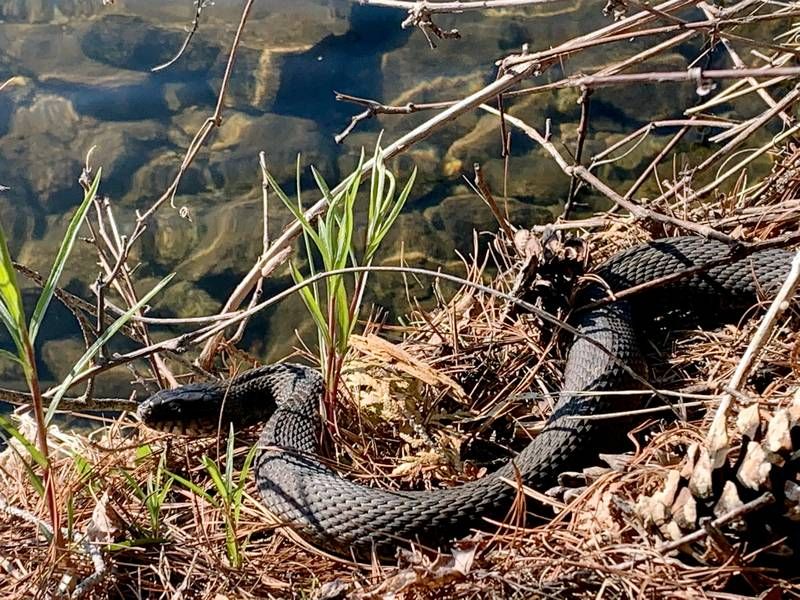John Curran | Jun 17, 2020
Meet Tito. He’s one of almost countless snakes I’ve seen around our place this spring, the tip of a craggy Canadian Shield peninsula on Buck. Tito, a juvenile ratsnake, is not the longest or the shortest, but he’s far and away the most audaciously marked – he got his name because his stunning scales reminded me of the snake version of mariachi band performer. He loves to climb trees and eats primarily small mammals, and birds.
Tito doesn’t know how well he’s got it being born when he was. You see in the late 1900s there was a war that raged against snakes – back then it was truly an inter-species conflict, albeit completely one-sided. Everyone around the lake seemed to kill any manner of snake they saw. It was like Whacking Day every day across most of cottage country.
Over the years fortunately most former snake killers have reformed. When you see the problems in the world nowadays, it is easy to understand there’s plenty worth fearing without wasting time on illogical stuff like snakes.
Snakes are in fact some of our closest and most-valued neighbours here in South Frontenac. In this time of plague, I’m sure most reasonable people would agree a few snakes around is better than a return of the Black Death, to say nothing of the damage mice can inflict on rural properties each year. Without snakes, especially Tito and other Pantherophis spiloides, or gray ratsnakes, as they are more commonly known, we’d be overrun by rodents.
Well, er, I guess saying it is “correctly” known as the gray ratsnake, would be more accurate. Some folks call them pilotsnakes and others oaksnakes. I like most grew up calling them black ratsnakes – or simply black snakes. Ontario’s largest snake, mature adults are primarily dark black (especially here in the Northern part of the range), with or without faint traces of a pattern, to dark or medium gray, but can also include pale brown to almost white with distinct brown and gray blotches. Younger snakes, like Tito, are a beautiful mix of black, gray and white.
According to the Ontario Ministry of Natural Resources, two populations of gray ratsnakes in Ontario are in trouble. The one that matters to us in this neck of the woods is the threatened Frontenac Axis population. “Threatened” means the species lives in the wild in Ontario, is not endangered, but is likely to become endangered if steps are not taken to address factors threatening it.
The most significant threats to the gray ratsnake are the loss and fragmenting of habitat and persecution by people. Other serious threats include motor vehicles and the destruction of suitable hibernation sites. Since ratsnakes hibernate in groups at the same site year after year, destroying these sites can have a large impact on the local population. The gray ratsnake is slow to mature and reproduce, which may also inhibit recovery of this species.
This year is our first getting to live here since buying our place in 2017. It’s clear the snake population has done quite well since the dark days of the last century. I am extremely impressed with nature’s ability to rebound, it’s not uncommon for me to see five or six different snakes in the course of a day across all three primary species we’ve got here, including the northern common watersnake and the eastern gartersnake. Two or three decades ago, I recall we could go all summer and see fewer than 10 snakes. That said you can see the same trend in the deer population as hunting, unfortunately in this case, slips further away from mainstream life for most Canadians. The result is an animal explosion. Deer are everywhere nowadays, and so are deer ticks.
Our interaction with nature is near chaos at best. All actions have consequences, intended or otherwise. Pests notwithstanding, my rule of thumb is that it’s alright to kill almost any animal you want, providing you’re operating within the bounds of the law and as long as you or someone else intends to make use of the meat. If we follow this guideline and give Mother Nature a little room to breathe, there should always be enough nature for those who want to observe it and those who want to eat it. And maybe even a few less folks who fear it.
So unless you’re auditioning for the next season of Alone or Les Stroud in a survival situation, let’s leave the snakes be, okay?
By the way, according to the Peterson Field Guide to Reptiles and Amphibians the record gray ratsnake is 84.25 inches (214 cm). I bet if we all stay vigilant there’s a world record to be found, as stories of seven-plus-footers are not uncommon in our region.
More Stories
- The Resurgent Sharbot Lake County Inn and Crossing Pub
- Towards Then End of Trail
- Silver Lake Pow Wow
- Central Frontenac Declares Former Office, Harvey Building, Surplus Properties
- Neighbours Could Lose The War Over Gravel Point - But Still Win The After Battle
- Sydenham Legion Bass Tournament
- From Performing Arts To The Written Word
- Legion Corner
- The Sun Shines On The Parham Fair
- Creating Your Own Weather, Forever and Ever

